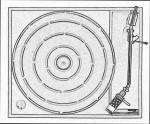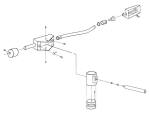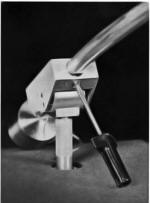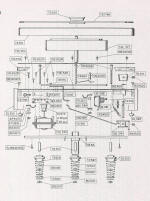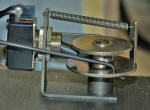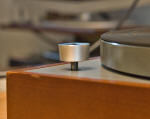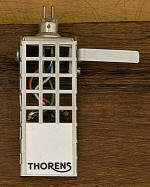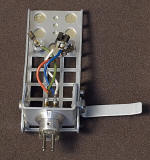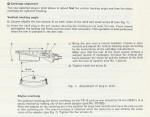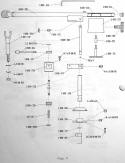-edible zone-
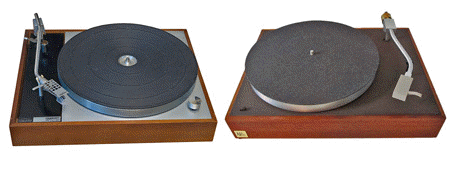
-- Above: The TD150 and AR-XA Turntable. Not exactly a mirror image.
-- In The Beginning... the story of the TD150 doesn't start with Thorens in Switzerland. It starts in the United States with Edgar Villchur at Acoustic Research. As it turned out, Villchur, along with Mitch Cotter were to be the progenitors of the Thorens TD150. Villchur had developed and produced a turntable that would have considerable influence on turntable design of the 1960's and thereafter. They called it the AR-XA. We knew it as The AR Turntable. Say that and everyone knew which one. The AR Turntable was innovative, solid, and compared to all others in 1961 it was plain simple. They priced it at $58 and the sales flowed in.
The essential design principles of the AR-XA were as follows:
- All relative motion between tone arm and platter was to be immobilized.
- Platter and arm must be isolated from motor vibrations as well as from external shock
- The pick-up must have insulation from the bombardment of acoustic airwaves (aka acoustic feedback)
The first principle was accomplished by mounting both the platter and tone arm to the same rigid structure that came to be known as a sub-chassis.
-- The second principle was accomplished by using rubber grommets holding conical coil springs to carry the sub-chassis from just below the top plate holding the motors. The combined mass of the platters, sub-chassis and tone arm was kept very low. Then a rubber elastic belt between the driving motor pulley and the driven inner platter insulated the platter from the motor while driving it. The motor itself was a new idea....it was an AC synchronous type where its rpm was governed by the line frequency. It was small in size as well as in output. It's low output in combination with the slow rpm were the features that enabled the much lower vibration levels coming from it during operation. In order to accommodate this small motor, AR developed a light weight platter system consisting of two aluminum platters arranged as inner and outer. The inner took the drive from the belt. The outer, which carried the platter mat and record, could be lifted off by hand so that the owner could move the rubber drive belt between the 33-1/3rd and the 45 rpm steps of the motor pulley.
--The third principle was accomplished by the sprung sub-chassis.
In magazine ads we were often reminded that you could pound your fist on the top surface of the AR turntable and not skip the record. Sometimes the ad used a hammer. We saw this not only in ads but also it was reported in product reviews that this was indeed the case. An impressive, though perhaps unbelievable until-you-saw it, example of isolation from physical shock.
*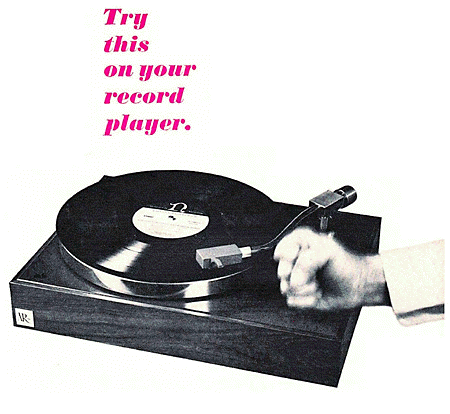
Exploded assembly - AR XA
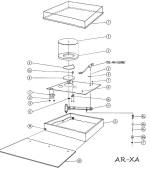 (hint: click on thumbnail to view image full size)
(hint: click on thumbnail to view image full size)
*
-- Above image: The Acoustic Research AR-XA turntable.
At introduction in 1961, The XA featured some components that were later modified or eliminated entirely. Most notable among those were the two motors. The primary motor was synchronous. It operated at 400 rpm and was used to propel the platter system. However this motor was perfectly able to run in either clockwise or counter-clockwise direction and so Villchur thought it needed a second auxiliary motor - a smaller synchronous motor - to get it started in the correct direction. The smaller motor, operating at 600 rpm, was used to support the main motor during start-up.
* Left: the twin motor pulley and belt
arrangement viewed from top side.
Left: the twin motor pulley and belt
arrangement viewed from top side.
* Left image: an example of the twin motor
version seen from underneath, and with the somewhat later cast
sub-chassis. Notice the solid walnut cabinetry.
Left image: an example of the twin motor
version seen from underneath, and with the somewhat later cast
sub-chassis. Notice the solid walnut cabinetry.
-- According to the service manual this two-motor system was used up to serial number XA66866. Then between XA66866 and XA175235, a single Haydon drive motor was used. Then between serial numbers XA176235 and XA204462 a single Philips drive motor was used. The service manual recommends that, for the early two-motor systems, a Haydon conversion kit needs be used to convert the system to a single motor drive. It also notes that the Haydon motor is preferred over the Philips and it reports a difference in size between the respective rotor shafts and that the drive pulley must accommodate this difference in shaft diameter between the two motors.
There was also evolution in the sub-chassis design. The early version was a spot-welded steel assembly with detachable bearing housings for the platter and tone arm. Early bushing materials were problematic, resulting in seized bearings. The bushing material was revised. Then came a cast sub-chassis (aluminum) with the bearing housings - both platter and tone arm - as a solid part of the casting.
--#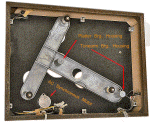 (hint: click on
thumbnail to view image full size)
(hint: click on
thumbnail to view image full size)
Above photo: a later single motor example, with cast sub-chassis and particle board cabinet.
Beneath the top plate it hangs by three threaded studs holding coil springs insulated by soft rubber grommets. Also note how the platter bearing housing and the tone arm pivot bearing housing are integrated into this cast chassis providing a constant and solidly fixed distance between platter and arm. In this uncompromising design the AR-XA was restricted to its integrated tone arm. Initial price in 1961 was $58.00 usd, soon to be raised to $78 usd and by 1972 a new XA could be purchased for $90.00 usd.
That AR arm:
The factory service manual describes the tone arm as an aluminum tube with a removable low-mass plastic head shell at the one end and with a brass counterweight on the other end. The counterweight is used to set vertical tracking force by means of a set screw to fix its position along the length of the stub shaft. Its pivot on the horizontal consisted of a shaft turning in bushings and with a bearing ball thrust at its bottom. That part of it fit down into the cast housing within the sub-chassis.
The pivot for vertical motion was arranged by cones fitting closely into cups. An outer cast structure carried the vertical pivot screws, arm tube, stub shaft. It is referred to in the service manual as "the central coupling block". Another assembly, fitting under and within, carried the horizontal pivot assembly which connected to the 'central coupling block' by the conical tipped pivot screws. It was these conical tipped screws that governed tone arm motion in the vertical. A very precise adjustment was required in order to achieve its optimal tracking of the record groove.
Another feature of the vertical pivot is that it was on approximately the same horizontal plane as was the stylus while in the record groove. This was intended to reduce the effects of 'warp-wow.
There is a viscous-damping system that allows the arm to fall slowly when dropped in order to save on stylii and records. The arm has no cue-device nor does it have provision for anti-skate. To accommodate for the lack of anti-skate the service manual advises to adjust down-force by an additional 1/2 gram.
-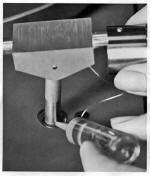

 (hint: click on
thumbnail to view image full size)
(hint: click on
thumbnail to view image full size)
-- Above 6 images are taken from the service manual.
-- To get an idea of how well this new model was received in the public we might look toward the company sales ledger. And AR had as many sales for turntables as they had turntables to sell. We can also look at the magazine reviews it gathered. In the United States, the three most popular hi-fi magazines at the time were: Audio, High Fidelity and Hi-Fi / Stereo Review. Nearly sixty years later this short list of magazines is what comes to my mind as representative of what we had for hi-fi media in the US. Although I was able to pull up one review for the TD150 by J. Gordon Holt at Stereophile in the Autumn 1966 edition. This review can be found at two sources I know of, including Stereophile.com. See that one further down the page where we get to the Thorens.
For the greater part I found my sample reviews online at https://worldradiohistory.com The magazines I found there are scanned copies of originals that date back to the early 20th century and go forward from then. The material within that site varies with regard copyright laws and whether or not it would be advisable to reproduce them over the internet on this website. Instead what I offer below is a summary of each review. Their meanings, my words....except for one sentence quoted in the March 1963 Hi-Fi/Stereo Review equipment review by J. Hirsch.
![]()
-- Magazine Equipment reviews of the AR-XA:
Hi-Fi / Stereo Review - March 1963
Acoustic Research Record Player (Price - $58)
Reviewer: Julian Hirsch
Measure test results by Hirsch-Houck Labs:
Wow and Flutter: 0.05% and 0.02% respectively.
Rumble: -38 db with both lateral and vertical components, and -40 db with vertical components cancelled.
Speed accuracy: no figures offered but the reviewer described the speed as "exact".
The reviewer described the player as combining the best features of both the light and heavyweight approach to turntable design. He reported the twin motor system having its main motor operating at 400 rpm while providing the main operating torque, but with no starting torque. A smaller clock-type synchronous motor operating at 600 rpm starts the main motor and supplies about one-sixth of the running torque. The turntable itself is "about three pounds" aluminum platter, with a plastic foam pad. (platter mat).
The arm he described as we've come to know it; a simple aluminum tube with a removable low-mass plastic head shell; and at the other end an adjustable counterweight that established the stylus force. Stylus overhang was adjusted by means of a plastic gage supplied with the turntable. He describes a viscous-damping system that allows the arm to fall slowly when dropped, but this damping system disengages as the tone arm touches down on the record.
He did note a tracking error larger than rated when the cartridge overhang was adjusted per instructions. This tracking error varied from 0.4 degrees per inch to about 1 degree per inch instead of the rated maximum of 0.32 degrees per inch. Then he noted that the manufacturer acknowledged the tracking error figures and reported that there was an error in the construction of the hand-assembled test unit and that regular production units would be produced with assembly jigs designed to eliminate this production error.
The reviewer's description of the "arm-turntable" suspension is very interesting. Here is my paraphrase... The arm and turntable are mounted onto the same rigid I-beam and this system is suspended from the motor board on compliant springs. Because the motors are fastened to the motor board, the result is near total isolation of the record-playing apparatus from external forces. His next sentence supports those hammer and fist advertisements seen in the audio magazines. This I feel the need to quote exactly in the writers words as follows
quote/
"The motor board can literally be pounded with a hammer without producing a thump in the speaker, let alone any groove-jumping, even with a 1-gram tracking force"
\end quote
Hirsch also commented on the rumble being generated by the 400 rpm motor. He noted that, at 400 rpm, the motor would produce its rumble at around 8 Hz and that is below human audibility. Then he explained that, In practice, the only rumble that might be heard with the AR turntable is coming from within the record itself.
On the subject of acoustic feedback the reviewer observed that the records he played on the AR turntable had an unusually clean and clear quality. There was a complete freedom from acoustic feedback which, he suggested, was responsible for this. He also noted there was no audible wow heard when a record with a 1/4" warp. (ed: So I gather he kept a 1/4" warped record around just for that test..)
We don't learn until the last sentence that the AR-XA reviewed was a single speed model. (33-1/3rd only.) That's when he mentions that a two-speed model (33-1/3 and 45 rpm) would be available shortly for $68.
end review summary
![]()
-- High Fidelity equipment review 1963 -03
Acoustic Research Turntable and Arm (Price - $58)
Reviewer: not identified
Lab tests by United States Testing Company, Inc., Hoboken, NJ.
Rumble was reported at: -38db. Wow - 0.08%, Flutter - 0.04% Speed accuracy within - 0.05% of nominal at 33.
Speed accuracy error of 0.05% deviation from nominal.
Review Summary:
The review begins with "At A Glance" and describes the review sample - the single speed model, followed by an announcement of the new two-speed version available at $68.
The reviewer makes note of the lab test results then suggests that the new AR is a very well-engineered product and that not only does it offer quiet and accurate performance, but it is highly immune to the effects of external shock and feedback.
The article reports the platter mass for the turntable at 3.3 lbs total
The reviewer describes the twin motor drive as being of the synchronous kind. He notes that: a trait of the main motor is its ability to run clock-wise or counter clock-wise, depending on its initial push. Once operating, it locks in to the line frequency with its' speed being independent of voltage level. To get it started in the correct direction another motor is employed through a second belt to the shaft of the main drive motor. When the player is switched on, the starting motor activates the drive motor which then takes over to spin the platter. He describes the operation as being smooth, silent and fast. Then he notes that this twin motor AR turntable has enough torque to reach its operating speed in less than a single rotation of the platter.
While taking note about the arm the reviewer describes the damping mechanism that can be adjusted to cause the arm to descend onto the record slowly. When properly set, this damping prevents possible damage to a record in that, even when it is dropped by the user, the arm will float gently down to the record. Once the stylus engages the record groove, the damping is released and the arm tracks freely. (ed. note: To this point I gather that, in practice, there is an adjustment that needs be made to this damping mechanism before it functions properly)
Another excerpt about the essential design: " Platter and arm are both mounted to the same rigid frame that resembles a steel "I" beam located beneath the motor board. This frame is suspended by three springs. This system has a large time constant. The effect of it is to isolate the arm and pickup from any physical or acoustic influence apart from the groove of the record being played.
The unit resists external shock, floor vibrations, and acoustical feedback. The AR turntable and arm combination is well enough isolated that it can be given a hard vertical blow with a fist or a hammer --- and not cause the stylus to skip. While this feature makes for a dramatic display at product demonstrations, it also has a very practical benefit in home music systems, where often the problem of acoustic feedback exists and can "muddy up" the bass response, particularly when robust wide-range speakers are employed. The AR player remains clean-sounding despite creaky floors or persons walking across those floors. Its high immunity to vibration also suggests its suitability for installations in which the speakers must be kept close to the other components, including the type in which all the components are housed in the same cabinet.
To close, the reviewer notes that the AR player is indeed a remarkable product especially in view of its low cost.
end review summary
![]()
-- High Fidelity equipment review 1965 - 08
Acoustic Research Model AR-XA Turntable and Arm (Price - $78)
Reviewer not identified.
Testing conducted at: United States Testing Company, Inc. Hoboken, NJ.
Wow and Flutter: 0.06% and 0.02%
Rumble: -36 db per NAB std of 1.4 centimeters per ssecond at 100 cps(Hz)
Speed error: 0.28% deviation from nominal
Review Summary:
The reviewer team notes changes made to this turntable in comparison to its earlier review sample from 03-1963 as follows: It is now a two speed model (33-45) and that speed change is accomplished by removing the outer platter by hand and moving the belt between the two steps of the motor pulley.
The reviewer team notes improvements made to the suspension system which were already excellent are now better at handling horizontal shock which makes this new player ideally suited for installations in which environmental jarring, such as floor vibrations are a problem.
The reviewer team notes improvements made to the arm damping mechanism in that it is now somewhat easier to adjust and that it proved to be reliable in their tests.
The reviewer team comments about the arm's friction, both lateral and horizontal, stating it was very low and that it was suitable for use with the day's finest cartridges and at the low tracking forces recommended. Then the final comment was that the AR Turntable seemed to be first-rate equipment that could be used in the finest of music playback systems.
end review
![]()
-- Stereo Review, August, 1967
Acoustic Research XA Universal Record Player (Price - $78)
reviewer: Julian Hirsch
Hirsch-Houck Labs Test Report:
Wow and flutter: 0.035 and 0.03%, respectively at 33-1/3 rpm.
Un-weighted rumble per NAB std was -38 db including vertical and lateral components. They measured -42 db with vertical components cancelled out. States that these figures are among the best their lab has ever tested.
Review Summary:
The Reviewer describes what an outstanding example of high caliber performance at a low price the AR XA has been. Previous review sample was a single speed unit. This one is two speed. Speed is changed by lifting off the platter and shifting the drive belt to a different land on the stepped drive pulley
The reviewer notes that without notice AR changed the twin motor drive to a single motor using a specially designed unidirectional 300 rpm permanent magnet motor. This review sample has that.
The reviewer notes improvements made to the 'integrated tone arm / turntable mounting system. Now the 'new' sub-chassis is a casting which improves the rigidity of the coupling between arm and platter. It 'floats' on damped springs thus isolated from the motor board from which it hangs. Describes it as being mechanically isolated from external vibrating forces, including the motor. Calls it a mechanical low-pass filter that stops external stimuli from reaching the platter and arm.
The reviewer offers a pithy description of the isolated assembly that carries both platter and arm. He notes how shock forces that do reach the suspended sub-chassis moves them both as a unit because they are solidly coupled. Then states that because there is no motion relative between the pickup and the record, the impact does not reach the stylus. He goes on to say that because this isolation is so good he could mount the turntable both on top of and in front of speakers while playing records at high volume with no evidence of acoustic feedback.
The reviewer adds notes about the arm. He describes it as 'deceptively simple' in appearance but that it appears to be carefully thought out. He notes how 'low mass' cartridges on the arm can effectively track warped records.. He describes the vertical Pivot point to be nearly on the same plane as the record, minimizing wow when playing over warped records.
The reviewer notes how the viscous damped vertical pivot allows arm to float gently down to the record surface when released, yet the damping disengages in time to track the groove without any harmful drag.
The reviewer notes several minor design updates: modified suspension lowers sensitivity to shock in the horizontal by a factor of several times, More reliable pivot damping system, updates to older version can get the full update package from AR for only $15.
The reviewer announces that AR has just introduced the XA Universal, which has a switch that allows 120 volt or 240 volt operation. He notes that it comes with both 50 and 60 hz drive pulleys. Then reveals that this review sample is the XA Universal.
The reviewer reports his lab test results as follows: Wow and flutter tests low at 0.035 and 0.03%, respectively at 33-1/3 rpm. Unweighted rumble per NAB std was -38 db including vertical and lateral components. They measured -42 db with vertical components cancelled out. States that these figures are among the best their lab has ever tested. He states that the above test values are slightly better than those measured of one of the early AR single-speed turntables that they had tested several years ago. Says that the differences aren't significant and since the performance was already outstanding, it wouldn't seem likely to improve on those by any large margin.
The reviewer notes that the tone arm had a tracking error of less than 1/2 degree per inch for record radii between 1-1/2 to 6 inches. States that its 'feel' was excellent and takes note of the comfortably shaped finger-lift that has no tendency to "get away" from the user even when operating at 1 gram stylus force. He states that AR doesn't include anti-skate features, insisting that the benefits of such devices are not enough to merit inclusion since a minute increase in tracking force will accomplish the same reduction of distortion as would anti-skating compensation.
The reviewer notes that speed accuracy of the review sample was "exact" and not affected by line-voltage variation.
The reviewer concludes his review by listing everything that comes with it, reports both prices of the US and Universal models at $78 and $87, with a three year guarantee, blah blah then recommends it over turntables priced two or three times higher but names no names..
end review summary
![]()
-- One thing the Reviewers missed......
* hint: click on thumbnail to view image full
size
hint: click on thumbnail to view image full
size
-- The above advertisement taken from Stereo Review, Sept. 1966 takes a humble step back and makes a retraction of sorts. The ad makes note that not all ARXA owners have enjoyed complete isolation from mechanical shock. It goes on to say that "investigation showed that under special conditions the complaints were justified; when a floor was exceptionally springy or when the AR turntable was placed on a shaky surface (factors introducing a horizontal shock component) the much vaunted resistance to jarring disappeared."
Perhaps the above reviewers, all of whom had made raving claims about resistance to jarring, lived in abodes with solid flooring. As it turns out residential architecture was in the process of putting springy floors in a large percentage of all housing at the time and on into the future.
Fast forward into the present (circa 2020's) when many of us have been living on springy flooring for much of our lives. And the ARXA was no miracle. Yes indeed foot-fall will skip the needle out of the groove on one of these little turntables. Let's keep that in mind as we take a close look at the TD150.
*![]()
-- The AR-XA was known to me during the 1960's. (We called it "The AR Turntable") By 1970 I had graduated from high school, but before that I have a memory of an AR-XA up on top of a steel audio-video stand in the band room. The stand was on wheels. And the flooring was very solid, not springy. The AR fed its signal, coming from a Shure cartridge, into a Dynaco separate amp and preamp setup....with vacuum tubes! The electronics instructor had assembled those from a kit.
This AV rig was located down in front so that McFarly - fearless leader of the band - could play examples of the music we were attempting to learn. Up on the wall and facing us were a pair of Acoustic Research AR 3A speakers. As with the rest of that setup, they were new that year.
About McFarly - we knew him for his deep involvement into the music, on one or another occasion we knew him for his hot temper combined with an emotionally charged demeanor. He cared about it. He was a musician that played night gigs in a Dixie Band. Cornet. But a serious guy. The memory is that on occasion, when he wasn't anywhere to be seen, some of us would play a record on that AR-XA / Dynaco / AR3A setup. This was my first introduction to the world of good quality playback. And those AR 3A's, even way up on the wall as they were, did do it. The band seating was like that of an orchestra in a concert hall with those in back up higher. It was the 1968-69 class year and the record was Blood Sweat and Tears, second album, side two - Spinning Wheel.* It sounded to me in a way I hadn't heard before and my teenage mind became obsessed with the idea of getting my own rig.
*Yep, he did catch us at it, but after a close inspection of the stylus the old goat relaxed and went into his office.
Right then I knew that I absolutely had to have a hi-fi rig...but without a McFarly!. I was now in need of a better paying job. Although, for some reason, the AR XA was not my first turntable nor did I ever get one. Maybe I should have.
*![]()
-- The Story of the TD150: By the mid 1950's the Long Playing record had been introduced nearly a decade before and Thorens was still using an electric gear-motor to drive their current turntable, the CBA 83. They were behind the times and knew it. As Joachim Bung tells it in his book "Swiss Precision 2nd ed", the upper management of Thorens had reached retirement age and the new younger generation at Thorens was in position to take on the task of company leadership.
As a credit to all of them they had come from a proud family tradition. Originally the business was founded in 1883, by Herman Thorens, to make ornate and elaborate music boxes along with the wind-up spring-driven motors that powered them. Then, as time went by, they made wind-up acoustic gramophones when those became popular around 1906.
* (hint:
click on thumbnail to view image full size)
(hint:
click on thumbnail to view image full size)
* Left: a Thorens wind-up gramophone motor.
Left: a Thorens wind-up gramophone motor.
-- By 1928 their acoustic gramophones were electrically driven. A year later they had an electric pick-up for their new electric gramophones.
By the late 1940's they had produced electric motor powered - but still gear driven - automatic changers like the CD30:
* CD 30
(hint: click on thumbnail to view
image full size) Image courtesy of Jorge Vweb in the Thorens Gallery.
CD 30
(hint: click on thumbnail to view
image full size) Image courtesy of Jorge Vweb in the Thorens Gallery.
One of their changers - the CD 50 - could play records from underneath or on top. The idea of it was to be able to play both sides of the same 78 rpm record without having to get up and change it. See the two images below.
* (hint: click on thumbnail to view
image full size)
(hint: click on thumbnail to view
image full size)
* CD 50 Images courtesy of A_Ehrlich
in the Thorens Gallery.
CD 50 Images courtesy of A_Ehrlich
in the Thorens Gallery.
-- Would it not be interesting to compare this one with their TD224 robot arm changer (circa 1962)
*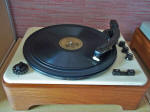 CBA 83 Image courtesy of Niels
Masselink in the Thorens Gallery.
CBA 83 Image courtesy of Niels
Masselink in the Thorens Gallery.
-- Up until the time when the Long Playing Record gained popularity, their machines were 78 rpm players that employed a worm-gear driven transmission to drive the platter. Everyone's was. But with the new and far slower rotating speed of the Lp (33-1/3rd rpm) the audible evidence of wow and flutter came under scrutiny and so it was determined by all in the industry that a new drive system was needed to better play back this medium. First came EMT with their R80, soon followed by the EMT 927 professional broadcast idler wheel driven machines. Then came Garrard with their 301 idler wheel player that could work both in the broadcast studio environment as well as at home. Seeing this Thorens knew they had to innovate if they were to continue selling record players. Their answer in 1957 was the TD124, a belt/idler player.
-- The well received Thorens model TD124 was a four-speed turntable featuring 16, 33-1/3rd, 45 and 78 rpm with a neon-lit strobe and a variable speed pitch control of ± 3% range. For the broadcast studio it offered instant start and stop cuing by means of a separate upper platter operated by a clutching mechanism to lower onto - or lift up from - the quietly spinning flywheel beneath. Introduced in 1957 it became their new flagship record player. It was marketed to and priced for wealthy amateurs. A turntable with broadcast abilities yet suitable for domestic use. It was sold as a motor unit only and then a tone arm, a cartridge and the base had to be purchased separately. In The United States the buyer first bought the motor unit ($99.95), then a tone arm ($59.95 - Ortofon RMG 212 or the Thorens BTD-12s for $50.00, or an ESL ), cartridges optional but think SPU on the Ortofon arm (Ortofon SPU-T $49.95) and finally choose a cabinet to hold the lot (from $10.00 - $35.00). Add it all up (plus sales tax) and we see that this was not at all cheap for the late 1950's - early 1960's..
*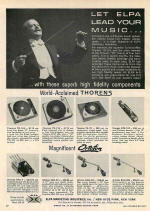
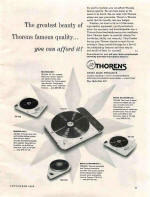
 (hint: click on thumbnails to view image full
size)
(hint: click on thumbnails to view image full
size)
-- Within their product line-up Thorens offered lower priced variants based on it -- like the TD134 and TD184 (semi-auto models). The TD110 and TDK101 manual models were the lowest price variants. The semi-auto TD135 was introduced in1962. These were all based on the drive-train of the TD124 but with variations in layout and different frame metals - but always it was a belt-idler transmission driving an idler wheel that put power to the inside rim of a platter. 1962 was the year when the lower priced TD121 was introduced in hopes of attracting buyers not wanting to spend as much as for the TD124. Using the same chassis and drive train layout it operated at one speed (33 1/3rd rpm), had no strobe, pitch control, or built in level and used a smaller platter bearing from the TD135. I'd better not omit the fantastic TD224 robot arm changer that Thorens introduced in 1962. However, as much as they worked at it, the sum total of sales and profitability was not enough to sustain the firm that Herman Thorens had started in 1883..
.By that year, 1962, much of their operation and employee mind-set was still organized around the traditional methods of hand-built machines assembled by skilled labor. Company leadership at the time could see that their product line was not cost competitive with other lower priced turntables on the market. Companies like Dual, in Germany, could produce their record changers of a quality just as good -- if not better than the TD134 and TD184 models while doing it at lower cost. And so did Garrard with their Type A record changers. It was clear that Thorens struggled to compete in the mid-priced consumer turntable market.
The TD124, for all its good ratings and fame, was not enough to keep the company afloat financially, so Thorens in 1962 merged their operation with Paillard SA who had agreed to purchase a controlling interest in the company stock.. Paillard was also located in Ste. Croix..... meaning that Thorens employees got to keep their jobs while moving across town into the Paillard facility. Thorens design engineers were tasked to develop new and more modern products. It was during the time at Paillard when Thorens developed the TD150. They had to.
*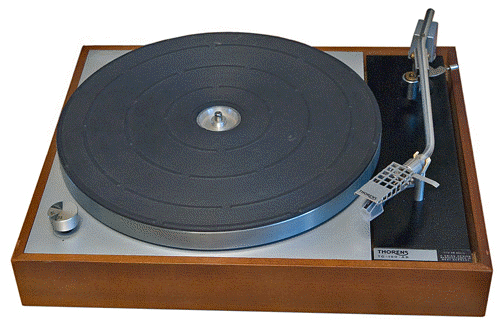
-- Above photo: Introduced in 1965; the Thorens TD150 AB, first version with the TP13 tonearm....Note: the AB designation indicates - with Arm and Base.
The TD150 story, (see Joachim Bung's book "Swiss Precision" - 2nd edition p.69) begins in 1963 with the Thorens head of development meeting with Edgar Villchur in Hawaii at a Rotary Club meeting. Villchur, head of Acoustic Research in the United States, and Amedee Nicole, head of the development lab at Thorens in Switzerland, talked about the AR XA turntable. Nicole must have related these discussions to Robert Thorens because he's on record for giving the go-ahead to develop the new belt drive model based on the AR XA.
*
-- Above image: underside view of a Thorens TD150 - first version.
The turntable Thorens developed employed the essential principles seen in the AR-XA but in execution there were some differences. The AR-XA installed a bearing housing for the tone arm on their cast sub-chassis, and in so doing restricted the unit to the integrated tone arm that came with it. Thorens designed a sub-chassis with provision to mount a replaceable arm board, hence making it possible to mount any one of several different tone arms per the owner's liking......and still retain a fixed distance between arm and platter regardless of suspension movement.
* (hint: click on thumbnails to view image full
size)
(hint: click on thumbnails to view image full
size)
-- Another difference was in speed selection. Thorens provided the ability to change speeds at the on / off knob. The knob itself was of the push/pull design. Pull upward to switch the motor on. Push down to shut it off. Turn the knob left or right to turn a crank below that operated a push/pull rod that in turn operated a lever out near the motor pulley. The lever pushed the belt up to the 45 rpm step or pulled it down to 33-1/3rd step.
By comparison, the AR simply gave its owner the convenience of an on/off switch. The early version of the XA was a single speed (33-1/3). Then later AR added a two-step drive pulley to the model. This added 45 rpm. To change speeds on the two speed version ya had to lift the outer platter off and then, by hand, move the belt between the two speed steps of its pulley. Then you put back the platter and mat, then put on the record. Perhaps it is not a big deal and simpler could mean better to some folks.
-- Another difference is in how the motor attaches itself to the top plate. The AR simply has its motor screwed down flat to the motor plate with two screws. The Thorens fastens its motor by three machine screws but with a further complication; the screw nearest the inner platter is spring loaded --- and by turning that machine screw it will adjust -tilt- the motor pulley angle either upward or downward in order to azimuth-align the motor pulley to the driven inner platter. The wisdom behind this feature is not always applauded, but I'm certain it did add to the production cost of the turntable. I can see why they did it. If the platter itself can be adjusted in attitude by means of the screw threads that fixture the three suspension springs from underneath, it stands to reason that azimuth alignment between the motor pulley and inner platter can become misaligned.
In practice, the suspension adjustments would be carried out not only to adjust overall height of the platter -- but also to get the platter leveled relative to its base, -- as well as adjusting oscillation direction of the suspended mass toward the vertical axis, and in the result there needs to be no serious azimuth error between drive pulley and driven platter. Right, a suspension tune-up adjusts three parameters by means of those three spring adjustments.
With the AR-XA Villchur imagined a turntable reduced to its simplest requirements with the fewest complications. (if you don't count that twin motor business!) With Thorens we have seen a company that from its beginnings produced intricate and complex spring motors to power music boxes, gramophones, shavers and then they made those amazing CD50 and TD224 record changers. Complex mechanics was in their DNA.
Motor output is listed at 4 watts. It's a 16 pole synchronous Alternating Current motor. There was no strobe to check speed accuracy. Nor was there a means to adjust speed pitch. The motor itself did lock its rpm into the mains frequency and by that method would maintain a constant speed. Same as the AR.
The platter system of the TD150 was very much like that of the AR-XA except Thorens machined theirs from zinc castings - and with both pieces combined - the system weighed 7 lbs (add inner (3lb) and outer (4lb) platters together). The factory rubber mat weighs almost another additional pound which makes it an 8lb platter system when a record is playing. The AR-XA used aluminum platters. I note that zinc has a material density of 444 lbs per cubic foot. Aluminum has a material density of 167 lbs per cubic foot. Assuming that the Thorens platter system was of similar size, --- the AR platters must have weighed only 38% of that 7lb Thorens platter system. Very light indeed. Magazine reviewers indicated a 3.3 lb platter system for the AR.
All of the above evidence tells me that Thorens did not want to exactly copy the AR-XA but to create their own rendition of the principal theories behind the AR-XA.
The TD150 was first introduced in 1965 as the TD150 AB and came standard with the TP13 tone arm. I found a magazine ad from 1968 that lists a price for the TD150 AB as $99.75 usd. (see ad image below) The buyer would then need to purchase a cartridge in order to complete the package. Often times the hi-fi store would offer installation and setup services for a nominal fee.
*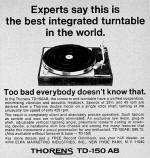 (hint: click on thumbnail to view image full size)
(hint: click on thumbnail to view image full size)
-- The TP13 tone arm bears similarity in design to that of the AR-XA. in that its horizontal pivot used a long bearing shaft in bushings with a thrust bearing at bottom. Gravity holds it there. Simple and relatively inexpensive to manufacture. There is no provision for anti-skate on either arm. These two tone arms are not noted to be exceptional at the task of tracking the groove, however I can find some articles stating that the Acoustic Research arm, with a little care, can function quite well. I'll have to settle for reviewer reports on either arm since neither gets much interest way out here already two decades into the 21st century.
-- The TP50 head shell was used by Thorens on four of their tone arms including the TP14, TP25, TP13 and TP13a.
See the TP13 manual instruction details just below.
-- Note that in the above instruction, the TP50 head shell features not only adjustment for overhang, but also it provides adjustment for vertical tracking angle. (VTA)
*
 Adjusting stylus down force.
Adjusting stylus down force.
-- The motor in the Thorens....
No doubt Thorens benefited from that talk with Villchur in Hawaii because their first product appeared using a single AC Synchronous motor operating at 425 rpm. Apparently Thorens found no need to experiment with a twin motor system in the way that AR had done just a few years earlier..
In the advertisements it was introduced as being two separate motors within the same casing around a common rotor shaft. Here's an excerpt from one advertisement...."Speeds of 33-1/3 and 45 rpm are derived from a Thorens double motor on a single rotor shaft, turning at the unusually low speed of only 425 rpm." Today this type of motor is commonly used in many different turntables and we are no longer in awe of the design. The type is regarded as a -two-phase AC synchronous motor that requires a timing capacitor when powered by the 'single phase' power coming from the wall socket in the home. Back then it was new to the world.
Examples of TD150 players I have seen show manufacturing id tags that report the motor to have an output of 4 Watts. Just enough to propel the 7 lb platter system and not much more. As is to be expected its lower rpm does result in lower motor vibrations in terms of frequency and amplitude. The reviewers tell us that the motor produces its rumble at 7 Hz, which is below human hearing.
![]()
-- How the TD150 did in magazine reviews....
High Fidelity 1966-05
Thorens Model TD-150AB Turntable - Price $99.75
Reviewer not identified
Measurements were made at Nationwide Consumer Testing Institute, Inc. (a subsidiary of United States Testing Company, Inc.)
Rumble: as per NAB standard (of 1.4 cm/sec at 100 Hz) was a very low -40dB and of course completely inaudible.
Wow and flutter were clocked at 0.07% amd 0.05% respectively,
Speed accuracy was measured as 1.95% fast for the 33-rpm setting, and 0.9% fast for the 45-rpm setting.
Review Summary:
The reviewer begins his description of the TD-150AB as Thorens' entry in the "uni-suspension" turntable class where the arm and platter share a common crossbar frame beneath the deck plate while being suspended by three springs. He then says the platter weighs 5-1/4 lbs and has a rubber platter mat with a built in pop-up 45 rpm adapter. (*footnote 1) .Then he notes it is belt driven by "two small synchronous motors operating simultaneously through a common shaft".
The reviewer describes speed change between 33 and 45 as being done by means of a stepped pulley on the shaft. Then goes on to describe weight of platter, size of the twin motors, and the drive and suspension system as being carefully chosen to make for a smooth, quiet operation.
The reviewer describes the arm as being well balanced, of low mass and is the metal tubular type with a removable head that accepted the modern cartridges of that time. He notes a cue lever that is pneumatically damped (*footnote 2). He describes the counterweight which is adjusted in combination with a removable stylus force gage
The reviewer calls the TD-150AB a handsome unit, a ruggedly built machine and a top flight performer. Then he gets into reporting the lab measurements which are to be seen at the header of this review summary..
The reviewer describes tracking ability of the TP-13 arm as being on par with the best. He gives credit to the isolated suspension system which contributes to the very quiet operation and that minimizes its susceptibility to external shock. Then concludes that the TD-150AB is a carefully built unit that should be welcome in a high quality disc playback system.
End Review Summary
*footnote 1: This value is incorrect. The combined mass of the inner and outer zinc platters (with bearing shaft) is weighed at 7 lbs on my scales over here. And the 45 adapter does not "pop up" it needs to be removed from the spindle pin by hand, turned over, and then replaced.
*footnote 2: The cue device is not pneumatically damped. (by air pressure) The mechanism is viscously damped by means of a thick sticky grease that slows descent of the stylus onto the record.
end review summary.
![]()
-- Stereophile, December, 1, 1966
Thorens TD-150 AB Record Player
Reviewer: J.Gordon Holt
Price as tested- $99.75
This review can be found online at the Stereophile website. I found it also in a vintage Stereophile magazine issue from the Autumn 1966 edition.
Review Summary.
After the introductory description sequence the reviewer proceeds into test results then notes the 'exceedingly low wow, flutter, and rumble measurements. Here he compares it to the AR unit and then notes the AR's natural rumble frequency is at 10 Hz, and the Thorens' is at 7.5 Hz. However, the writer fails to report any test values for wow, flutter and rumble, nor does he describe in any way how these 'tests' may have been conducted,
He reports that both speeds on his sample TD-150 ran about 5% fast. He then notes, as a result, a barely perceivable increase in musical tempos and how it raises the pitch of the music by a shade less than one semitone. Again the writer fails to report on the method of testing.
With regard the tone arm he noted that the arm pivots were badly out of adjustment. He found a considerable amount of free play in them and then observed that the arm appeared to be leaning over to one side and tilting the head shell by more than 5°. Then he proceeded to explain how 'they' were able to adjust these pivot bearings to get rid of most of the play without causing any excessive increase of binding -- but was " not able to eliminate all of the tilt from the head."
The reviewer discusses the type of the cone pivots and suspects issues with sample-to sample variability as a result of the production process in use..
In the performance observations (made after adjusting the pivots, we presume) the writer notes that the arm seemed to be tracking well but "was not quite as clean at a given tracking force as in, say, the SME arm."
The reviewer's conclusions....
The reviewer compares this TD150 AB to the AR Turntable but notes that the AR is far more accurate in running speed and its tone arm has demonstrated far less sample-to-sample variation. He notes how the Thorens was priced $20 higher and suggested that the AR was the obvious choice.
The reviewer continues his commentary by blaming the running speed issue on an over-sized motor pulley. Then he suggests that 'with this problem ironed out the TD-150 would make an ideal turntable for the perfectionist to use with the tone arm of his choice, etc.
With regard suspension isolation the reviewer noted that "when using arm cue lever the same suspension that isolates the base makes it easy to jiggle the whole playing system by the "rough handling of the lift lever." He also noted further that foot steps on a bouncy floor could easily cause the pickup to skip the grooves.
In response the manufacturer did add their comments as follows: In short. Thorens stated that the tone arm in the review sample had to have been damaged in transit or grossly defective otherwise. Thorens replied to the speed inaccuracy by stating that their in-house tolerances were ± 1% of nominal and that early units did see speed testing at the upper limit of that tolerance --- and that slight modifications were introduced in June of 1966 to reduce the average speed by slightly less than 1/3rd rpm. With regard the reviewer's negative comments on suspension isolation from external disturbance Thorens did comment to say that the spring suspension had been modified to improve damping and they feel it will eliminate the source of the reviewers objections concerning bouncy floor and the operation of the cue lever...etc.
end review summary
My take:
So here we have a mostly negative review coming from a magazine that put focus on subjective observations over lab measurements. I do feel that this review would have benefited from an independent lab test session where the writer could present his impressions and observations with support from a lab report rather than attempt to perceive (by ear?) semi-tone variation in order to assess speed accuracy. &&& That defective tone arm should have been returned to the distributor (Elpa) and replaced with an undamaged specimen prior to carrying out the review. .
![]()
-- Audio Magazine review - June, 1966 issue
Thorens TD-150 Turntable - Price $99.75
reviewer: not identified
Lab Test Results: Rumble -35dB, Wow and Flutter: 0.05% for both.
Speed accuracy: 0.5% fast
Arm resonance: below 10 Hz
Summary:
The reviewer announces that this unit is available only as a complete package and that none of its components may be had separately.
The reviewer describes the unit as: of the type that uses a common frame holding the platter and arm while being isolated by three springs from the base. The result of this design is a reduction in vulnerability to acoustic feedback and mechanical shock.
The reviewer describes the TD150 package as being formed around a two-speed turntable that gets its drive from a 'unique double synchronous motor' by means of a belt to its inner platter. Either speed is selected by the same control knob that is also used to switch the power on or off.
The reviewer describes the arm as a low-mass build. The aluminum tube is double curved, up forward to create the offset angle, in the rear to put the counterweight on a direction opposite to the offset. This, he says, results in a torsional balance around the pivot.
The reviewer takes note of the TP50 head shell in detail. He notes that in addition to the over-hang slide adjustment feature that there was also a tilt-adjust used to set vertical tracking angle (VTA)
Describes how the counterweight position is used to adjust stylus down force. Notes that there aren't any springs involved. Notes how the metal template fits over the rear of the arm and is used to adjust down force and that it is accurate to within 0.1 grams.
The reviewer takes note of the damped arm-lift mechanism and how it is useful even to butter-fingered operators like themselves.
The reviewer reports the lab measurements for rumble at -35 db below 1kHz and 3.54 cm/sec. in the lateral and vertical or in lateral only. Then notes that weighted measure with a 50 Hz chop-off produced a figure of -45 db. Then describes the practical result of the measure is to be heard when the music springs forth from a velvety silence...
The reviewer reports both wow and flutter as measured at 0.05%. Arm resonance was below 10 Hz. Speed Accuracy under load was consistently 0.5% fast.
The reviewer describes the spindle adapter. He says flip it over for 45rpm or 33-1/3 rpm record centers. Then notes it is also used for setting overhang.
The reviewer summarizes his review by saying that the Thorens showed much that was clever and good. It performed well. Had the promise of being durable. Then, finally, he says it looks good and recommends it without reservation.
end review summary.
![]()
-- About those three design principles that governed the creation of the AR-XA..... How well did Thorens do in meeting those same goals while producing a slightly more complex product?...I think the first place to look for answers is with product reviews coming from the magazines of the day. And we just read some.
So here it is again:
The essential design principles of the AR-XA were as follows:
- The relative motion between tone arm and platter was to be minimized
- The platter and arm must be isolated from motor vibrations as well as from external shock
- The pick-up must be insulated from the bombardment of acoustic airwaves (aka acoustic feedback)
How well did Thorens do at addressing these design goals....
With regards principle number 1, both platter and arm did share a common frame.
With regard principle number 2, I can allow the three above reviewers to answer as to the success of the isolation that Thorens managed to achieve. Holt's assessment seems correct to me that the suspension isolation on the Thorens was only partly successful and that it indeed is susceptible to being disturbed by external shock such as by footsteps on flexy floors, or even when the operator isn't careful handling the cue lever.
The TD-150AB did achieve very good rumble and wow/flutter measures in the two reviews that actually took those measurements which does testify to the ability of the design to isolate from motor vibrations.
However there are two reviews that report considerable speed error. The Stereophile report of 5% error seems incredulous to me and I'm tempted not to believe it. But the nearly 2% error as reported in the High Fidelity review (05-1966) does lend support to the idea that Thorens review sample was outside factory tolerance.
With regard principle number 3 and isolation from acoustic feedback Thorens received two out of three positives. And the negative was from J. Gordon Holt at Stereophile.
*
-- One of the advertised assets of the AR-XA was its insensitivity to mechanical shock as well as to acoustic feedback. The claim was that not only could you strike the top plate of the unit with a hammer (moderately, they note) but it would also be immune to the seismic disturbance known as footfall..... indicating that mechanical shock would not cause the needle to skip out of the groove. This had been publicly demonstrated numerous times and all the reviewers agreed with those claims after carrying out their own tests. However, we now know that the ARXA was indeed susceptible to footfall on flexy floors.
Thorens never did invite anyone to conduct the hammer and fist tests in the way that AR had. So, therefore, Rule 1 is; don't do the hammer test on the Thorens! (grin) Personally I wouldn't do it on the AR, if I had one here..... it would mar the finish! The idea I get, --perhaps--, is that Thorens did not achieve the same level of isolation from mechanical shock as did the AR. Another comparison is that the Thorens platter system - at 7 lbs - had more than twice the mass of the AR platters --at 3.3 lbs. Actually, I gather that the total assembly of the suspended sub chassis is indeed much heavier on the Thorens and is thus likely to react to horizontal shock with more drama than on the AR.
I can add some further insight into how the TD150 might react to external shock by noting some test observations I've made. The weight of the platter system (inner, outer and bearing) is enough to cause flexure of the subchassis frame on this unit. Using a dial indicator to measure deflection, I situated a bare subchassis up on three solid points near to the spring fittings. Then I oriented the indicator with its plunger in contact with the underside of the subchassis next to the bearing housing. Set the dial to read zero. Then fit the inner platter into its bearing housing...and the indicator read a frame deflection of .0025 inches. Next I placed the outer platter in position and the frame deflection read .007 inches. That's not much, but it does indicate that the platter system, even under static conditions, does flex the subchassis.
Currently I have yet to make the same displacement test to an ARXA. That would be interesting.
Consider what happens under dynamic conditions where the suspension of the TD150 has been excited into oscillation. I conjecture that the deflection will be greater under these conditions. Now let us think back to those three parameters that the design is meant to adhere to. In particular, item #1. "The relative motion between tone arm and platter was to be minimized" Clearly, any deflection under dynamic loading will violate this "rule". Further, in this dynamic mode, chassis deflection will alter distance between platter bearing center and arm pivot center. Very abruptly and repetitively at each oscillation. Perhaps it could be final nudge that skips the needle out of the groove. Conjecture, of course.
With what Thorens produced, we have the essential elements of the AR turntable but with greater mass in that floating sub-chassis and with three significant convenience features; 1) speed change controlled by a knob and 2) cueing the stylus by means of a lever located on the body of the TP13 tone arm and 3) the arm board is replaceable which enables the owner to choose an arm of choice. And this last idea lies parallel with the way that the TD124 had been engineered.
I now tend to see the AR-XA as a brilliant brainchild of its inventor, Edgar Villchur. His design was uncompromising in that he included the tonearm as an essential part of the system that provided insulation from external forces, including air borne and surface borne vibrations. He kept the total combined mass of the floating chassis low. By the look of it, the AR tone arm featured a design meant to be integrated deep down into the frame below that carried it.
Villchur made use of the small wattage, slow rpm AC Synchronous motor in this application. At first with two motors, a smaller higher rpm motor was used to correctly start the main motor. Then later simplified it to a single motor design as understanding of this motor type increased at Acoustic Research.
Thorens at the time described their motor as being two motors using the same output shaft. I suspect that this sort of prose had much to do with a marketing approach at attention getting. And I'm reminded that this was the third generation of Thorens upper management working to survive in the 1960's.
![]()
-- By 1966 Paillard had sold their controlling interest in Thorens to Wilhelm Franz at EMT. With that purchase Thorens moved their operation to Lahr, Germany in the same industrial area as EMT. They set up the new operation there while leaving their former employees in Switzerland behind..... many of whom remained employed at Paillard. Meanwhile, over in Lahr, the TD150 production was initially carried out in the EMT factory while Thorens got busy setting up a completely new operation near by.
Here's a detail photo of an armboard ID tag produced during the transition period when Thorens moved from Switzerland into West Germany.
* (hint: click on thumbnail to view image full
size)
(hint: click on thumbnail to view image full
size)
-- above photo courtesy of mygoggie
According to Joachim Bung in his book "Swiss Precision" 2nd ed, The TD124 and the TD135 -all versions - were always assembled in Ste. Croix even after Thorens had moved to Germany. The last of the TD124-II units had been assembled by 1968 and then the production stopped.
Meanwhile back in Lahr, Thorens worked with EMT to develop a new model based on the same principles as were the Acoustic Research XA and the TD150. But this one would feature some serious upgrades. It became known as the TD125. In fact Wilhelm Franz at EMT became so impressed with the TD125 that he commissioned EMT to develop a version of it for professional broadcast use. That model became the EMT 928. But that is another story.
End Part 1, TD150 History
-- Bibliography:
The historic material I have referenced is credited below.
Thorens content:
"Swiss Precision" 2nd Ed, by Joachim Bung
"Thorens; The fascination of a living legend", Complied and edited by Gerhard Weichler at Thorens, Translated by Seigfried Ludwig 1996
"The Lagacy of Thorens "TD" Series Turntable Classics". by Dr. Stefano Pasini
Audio Magazine
Hi-Fi / Stereo Review
High-Fidelity Magazine
Stereophile Magazine
AR content:
Article: A Tribute to Roy F. Allison (1927 - 2016), https://www.audioholics.com
Article: Acoustic Research Inc: The Golden Years" by Roy Allison : see this link: https://www.vinylnirvana.com
Article: A Glorious Time: AR's Edgar Villchur and Roy Allison / Dave Lander 2/6/2005, https://www.Stereophile.com
Article: A Classic Turntable's Forgotten Roots: the AR XA / Ivan Berger / PS Audio Issue 105 , https://www.psaudio.com
Article: Acoustic Research XA Turntable and Tonearm / Paul Seydor / -Sept.11, 2018- / The Absolute Sound https://www.theabsolutesound.com
Article: Acoustic Research AR-XA Turntable Review with Specs and Price / https://www.vintage-speaker-review.com
Hi-Fi / Stereo Review
High-Fidelity Magazine
Audio Magazine
and personal memories
End part 1;
*